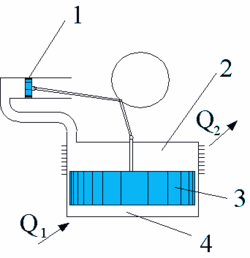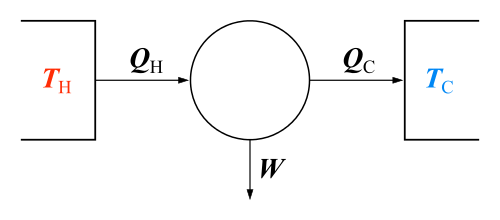Hot air engine
| Thermodynamics | ||||||||||||
|---|---|---|---|---|---|---|---|---|---|---|---|---|
The classical Carnot heat engine | ||||||||||||
|
Branches |
||||||||||||
|
||||||||||||
| Book:Thermodynamics | ||||||||||||

A hot air engine (historically called an air engine or caloric engine[1]) is any heat engine that uses the expansion and contraction of air under the influence of a temperature change to convert thermal energy into mechanical work. These engines may be based on a number of thermodynamic cycles encompassing both open cycle devices such as those of Sir George Cayley and John Ericsson and the closed cycle engine of Robert Stirling. Hot air engines are distinct from the better known internal combustion based engine and steam engine.
In a typical implementation, air is repeatedly heated and cooled in a cylinder and the resulting expansion and contraction is used to move a piston and produce useful mechanical work.[2]
Definition
.jpg)
The term "hot air engine" specifically excludes any engine performing a thermodynamic cycle, such as the Rankine cycle, in which the working fluid undergoes a phase transition. Also excluded are conventional internal combustion engines, in which heat is added to the working fluid by combustion of fuel within the working cylinder. Continuous combustion types, such as George Brayton's Ready Motor and the related gas turbine, could be seen as borderline cases.
History
The expansive property of heated air was known to the ancients. Hero of Alexandria's Pneumatica describes devices that might be used to automatically open temple doors when a fire was lit on a sacrificial altar. Devices called hot air engines, or simply air engines, have been recorded from as early as 1699,[3] around the time when the laws of gasses were first set out, and early patents include those of Henry Wood, Vicar of High Ercall near Coalbrookdale Shropshire (English patent 739 of 1759) and Thomas Mead, an engineer from Sculcoats Yorkshire (English patent 979 of 1791),[4] the latter in particular containing the essential elements of a displacer type engine (Mead termed it the transferrer). It is unlikely that either of these patents resulted in an actual engine and the earliest workable example was probably the open cycle furnace gas engine of the English inventor Sir George Cayley c. 1807[5][6]
It is likely that Robert Stirling's air engine of 1818, which incorporated his innovative Economiser (patented in 1816) was the first air engine put to practical work.[7] The economiser, now known as the regenerator, stored heat from the hot portion of the engine as the air passed to the cold side, and released heat to the cooled air as it returned to the hot side. This innovation improved the efficiency of Stirling's engine and should be present in any air engine that is properly called a Stirling engine.
Thermodynamic cycles
A hot air engine thermodynamic cycle can (ideally) be made out of 3 or more processes (typical 4). The processes can be any of these:
- isothermal process (at constant temperature, maintained with heat added or removed from a heat source or sink)
- isobaric process (at constant pressure)
- isometric / isochoric process (at constant volume)
- adiabatic process (no heat is added or removed from the working fluid)
- isentropic process, reversible adiabatic process (no heat is added or removed from the working fluid - and the entropy is constant)
- isenthalpic process (the enthalpy is constant)
Some examples (not all hot air cycles, as defined above) are as follows:
| Cycle | Process 1-2 (Compression) | Process 2-3 (Heat Addition) | Process 3-4 (Expansion) | Process 4-1 (Heat Rejection) | Notes |
|---|---|---|---|---|---|
| Power cycles normally with external combustion - or heat pump cycles: | |||||
| Bell Coleman | adiabatic | isobaric | adiabatic | isobaric | A reversed Brayton cycle |
| Carnot | isentropic | isothermal | isentropic | isothermal | Carnot heat engine |
| Ericsson | isothermal | isobaric | isothermal | isobaric | the second Ericsson cycle from 1853 |
| Rankine | adiabatic | isobaric | adiabatic | isobaric | Steam engine |
| Hygroscopic | adiabatic | isobaric | adiabatic | isobaric | Hygroscopic cycle |
| Scuderi | adiabatic | variable pressure and volume | adiabatic | isochoric | |
| Stirling | isothermal | isochoric | isothermal | isochoric | Stirling engine |
| Manson | isothermal | isochoric | isothermal | isochoric then adiabatic | Manson-Guise Engine |
| Stoddard | adiabatic | isobaric | adiabatic | isobaric | |
| Power cycles normally with internal combustion: | |||||
| Brayton | adiabatic | isobaric | adiabatic | isobaric | Jet engines the external combustion version of this cycle is known as first Ericsson cycle from 1833 |
| Diesel | adiabatic | isobaric | adiabatic | isochoric | Diesel engine |
| Lenoir | isobaric | isochoric | adiabatic | Pulse jets (Note: Process 1-2 accomplishes both the heat rejection and the compression) | |
| Otto | adiabatic | isochoric | adiabatic | isochoric | Gasoline / petrol engines |
Yet another example is the Vuilleumier cycle. [8]
See also
- Thermoacoustic hot air engine
- Carnot heat engine
- Timeline of heat engine technology
- Manson-Guise Engine
References
- ↑ Robert Sier (1999). Hot air caloric and stirling engines. Vol.1, A history (1st Edition (Revised) ed.). L.A. Mair. ISBN 0-9526417-0-4.
- ↑ Stirling (or Hot air) engine
- ↑ In 1699, Guillaume Amontons (1663–1705) presented, to the Royal Academy of Sciences in Paris, a report on his invention: a wheel that was made to turn by heat. The wheel was mounted vertically. Around the wheel's hub were water-filled chambers. Air-filled chambers on the wheel's rim were heated by a fire under one side of the wheel. The heated air expanded and, via tubes, forced water from one chamber to another, unbalancing the wheel and causing it to turn. See:
- Amontons (20 June 1699) "Moyen de substituer commodement l'action du feu, à la force des hommes et des chevaux pour mouvoir les machines" (Means of conveniently substituting the action of fire for the force of men and horses in order to move [i.e., power] machines), Mémoires de l'Académie Royale des Sciences, pages 112-126. The Mémoires appear in the Histoire de l'Académie Royale des Sciences, année 1699, which was published in 1732. The operation of Amontons' moulin à feu (fire mill) is explained on pages 123-126; his machine is illustrated on the plate following page 126.
- For an account of Amontons' fire-powered wheel in English, see: Robert Stuart, Historical and Descriptive Anecdotes of Steam-engines and of Their Inventors and Improvers (London, England: Wightman and Cramp, 1829), vol. 1, pages 130-132 ; an illustration of the machine appears on page 351.
- ↑ Robert Sier (1999). Hot air caloric and stirling engines. Vol.1, A history, page 56 (1st Edition (Revised) ed.). L.A. Mair. ISBN 0-9526417-0-4.
- ↑ Stirling engine history
- ↑ Detailed contents of the book Hot air caloric and stirling engines. Vol.1, A history
- ↑ Finkelstein, T; Organ, A.J (2001). Chapter 2.2 Air Engines. Professional Engineering Publishing. ISBN 1-86058-338-5.
- ↑ Wurm, Jaroslav (1991). Stirling and Vuilleumier heat pumps: design and applications. McGraw-Hill. ISBN 0-07-053567-1.
External links
| Wikimedia Commons has media related to Hot air engines. |
| Wikisource has the text of the 1911 Encyclopædia Britannica article Air-Engine. |
- Introduction to Stirling-Cycle Machines
- Pioneers in Air Engine Designs (Select the desired biography)
- Apparatus for the Method of Heat Differentiation Vuilleumier patent
